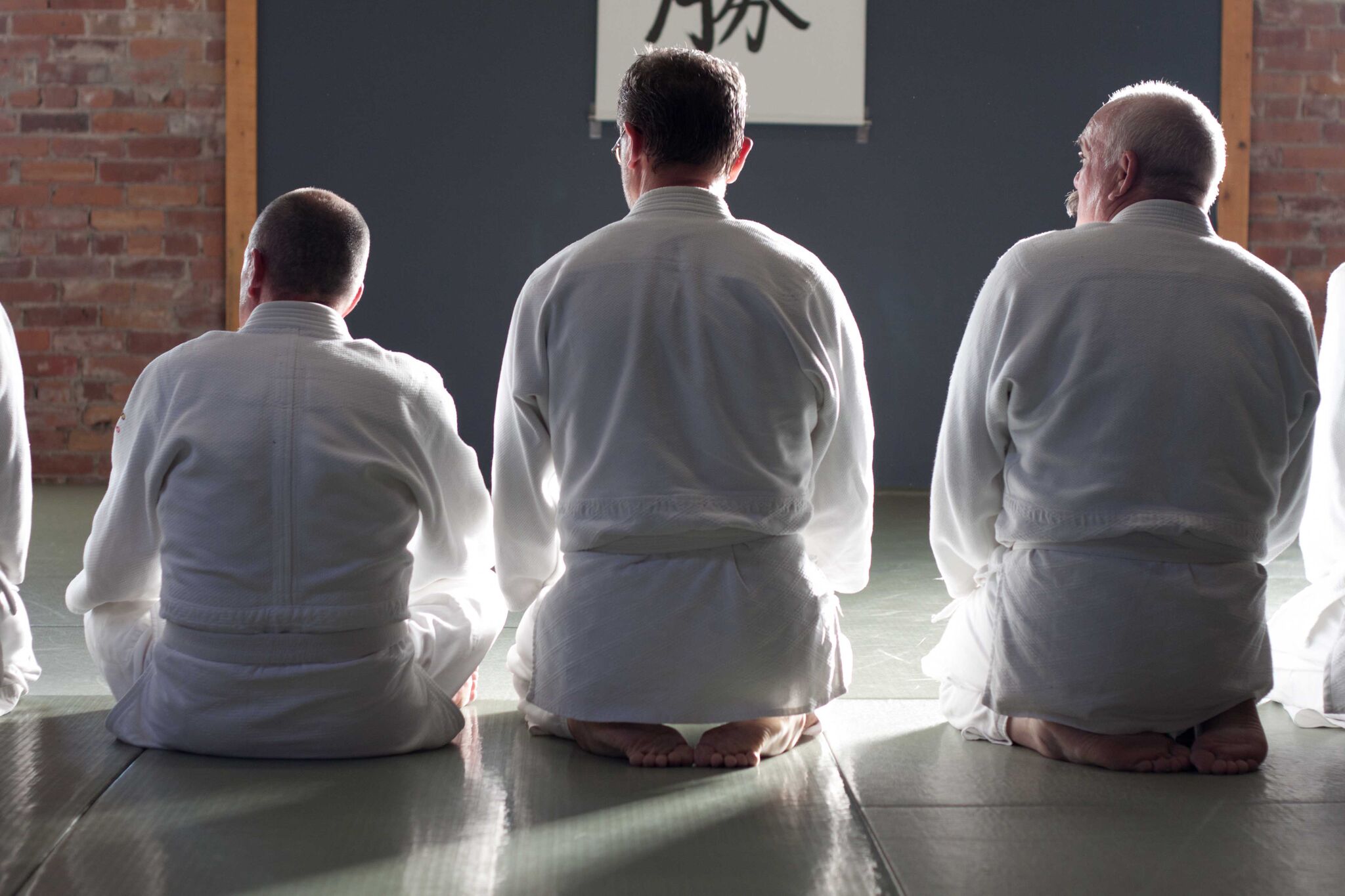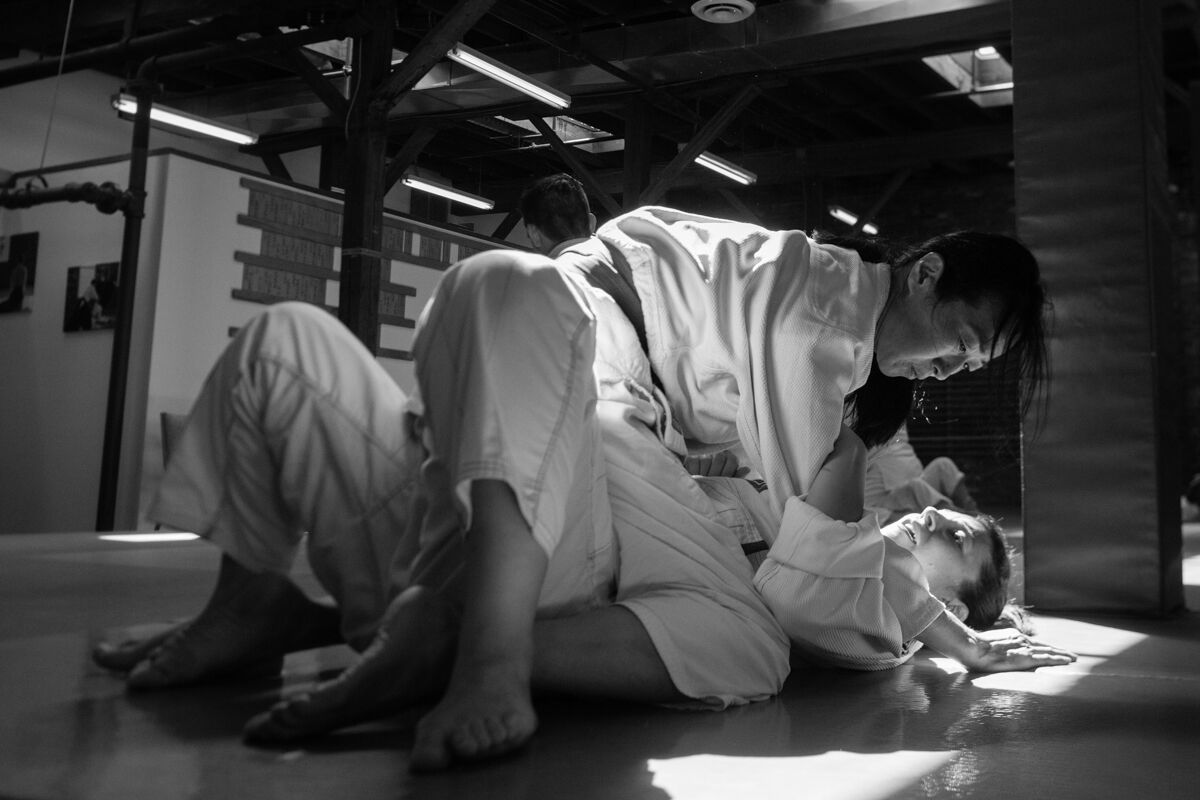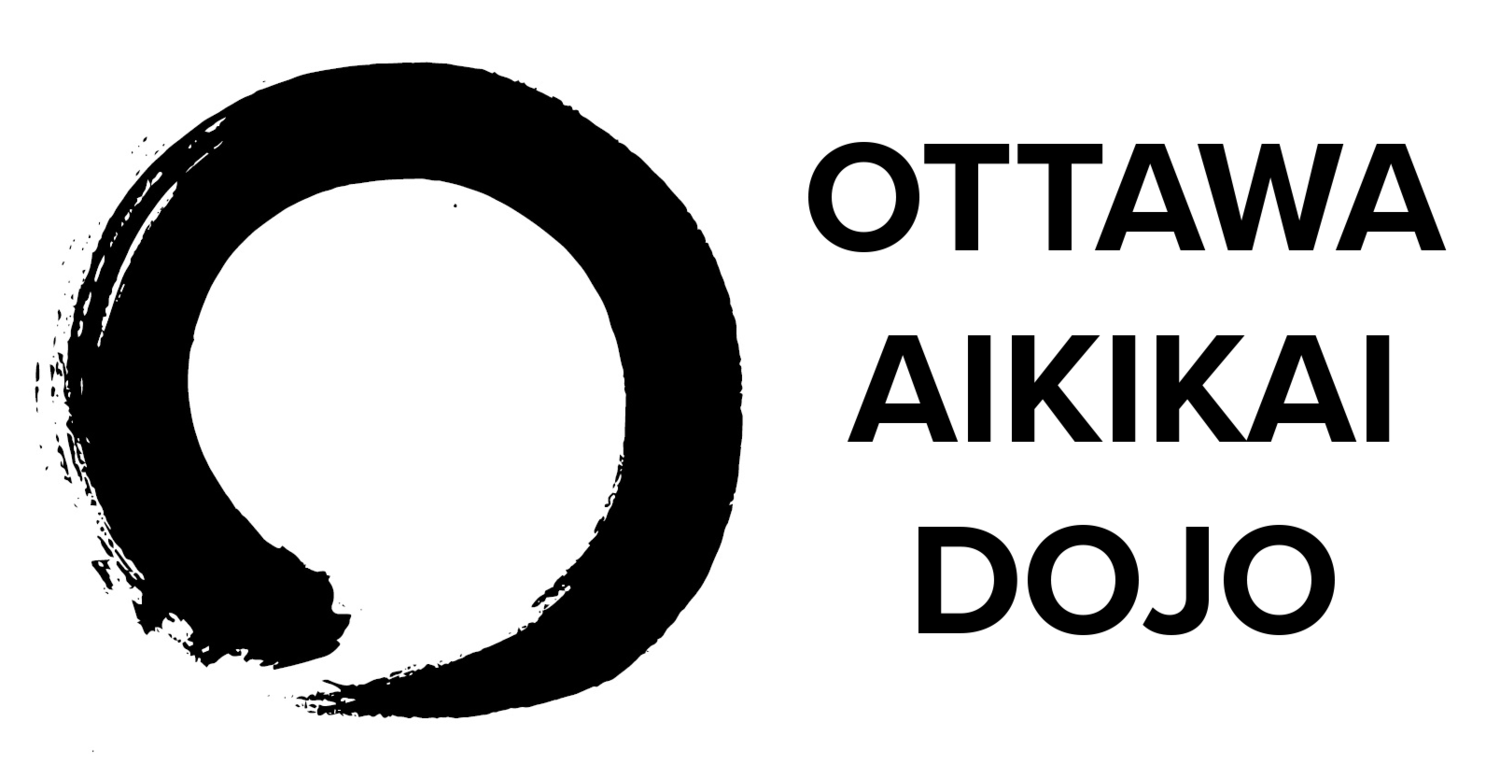
AIKIDO
Ottawa Aikikai
About Aikido
Aikido, a modern martial art created by Morihei Ueshiba (1883 – 1969) is eminently appropriate for today’s society. Though a relatively recent martial art, Aikido’s roots run deep. Morihei Ueshiba (often referred to as O’Sensei – Venerable Teacher) trained in a variety of martial arts. What seemed to have the most influence was both his training in various styles of Jiujutsu and training with different Japanese weapons (Kenjutsu), particularly sword and spear.
Drawing on both Jiujutsu and Kenjutsu, Aikido has both empty hand techniques as well as practice with weapons – boken (wooden sword), jo (short staff) and tanto (wooden knife). The movements are predominantly circular, using spiral movements to blend with the attacks. Aikido practice involves practice in both performing the technique (nage waza) and performing the attack and the resultant fall (ukemi waza). Aikido has an ethic that ensures that attackers are not harmed. However, do not mistake this for being ineffective – Aikido is a martial art and above all, techniques must be effective.
Through his years of dedication and training, O’Sensei became incredibly strong. However, he was also a deeply spiritual person -- a devout follower of the Japan’s traditional Shinto religion. He came to realize that the ability to overcome one’s ego was more important than the physical skill and practice. Ueshiba’s famous motto, “Masakatsu Agatsu”, contains the essence of the spirit of Aikido:
“True victory is victory over the self”
The name Aikido is composed of three Japanese words: ai, meaning harmony; ki, meaning spirit or energy; and do, meaning the path, system or way. Aikido is the way of the spirit of harmony.
“Aikido cannot be explained with words; one must practice and attain enlightenment of mind and body. Aikido training is not a sport nor asceticism; it is an act of faith based on the desire to achieve total awakening.” Abundant Peace, The Biography of Morihei Ueshiba, Founder of Aikido by John Stevens
The flow of ki throughout our bodies is a core belief within Aikido. Harmonizing our own ki through movement, with our attacker’s ki and through that harmony linking with the universal ki, is what is meant by “the spirit of harmony”. O’Senei had a much larger view of the world and saw Aikido to be more than just martial technique or a martial art. Rather he saw Aikido as a way of joining the peoples of the world together in peace.
“The true martial art is the one that defeats an enemy without sacrificing a single man; attain victory by placing yourself always in a safe and unassailable position. True budo is for the sake of peace and harmony; train daily to manifest this spirit throughout the world.”
- Morihei Ueshiba
.

IAIDO
About Iaido
Iaido (ee-eye-do) is a kata-based Japanese martial art mainly using the katana. Wooden boken may be used to practice this art, also commonly used are dulled practice blades called iaito. Instructors and very experienced Iaidoka may use a sharp sword called a shinken. There are some two-pesron kata performed with boken. A hakama is worn for Iaido at all ranks.
What sets Iaido apart from other sword arts is that it focuses on drawing a sword directly into a cutting technique. Most kata are performed solo, against one or more imaginary opponents who are the physical match for the practitioner. All solo kata start and finish with the sword sheathed. Most kata have four parts: the draw and cut (nukitsuke), the final cut (kiri kudashi), a ritual cleansing of the blade (shiburi), and returning the sword to the scabbard (noto). Emphasis is placed on posture and body alignment, forming good habits that can carry over to other martial arts.
Iaido does not teach one how to fight with a sword, rather, the kata are a framework for learning how to efficiently, effectively and safely handle a sword and all involved with it, such as the manipulation of the sheath (saya) and the strings (sageo) that secure the saya to the practitioner’s belt, as well as focus and attention to detail at all times while handling the sword or performing etiquette. Each kata involves different strikes, different targets, different timing and different ranges (maai), and all of them involve controlling the situation with the spirit as much as the actions, in order that one may eventually achieve victory with the sword still inside the saya.

JIU JITSU
Jitsu Ottawa - Community Club
Shorinji Kan Jiu Jitsu
About Jiu Jitsu
Jiu Jitsu (or jujutsu) is a Japanese grappling martial art that roughly translates to “yielding technique.” Students are taught to use timing, balance, connection and redirection to overcome an opponent without relying on physical strength. This makes jiu jitsu an effective self-defense system for anyone, regardless of athletic ability, gender, or size. We train in a friendly atmosphere with participants of all levels working together and senior students taking on instructional roles. Jiu jitsu at the Ottawa Aikikai Dojo stands out for its high-energy classes and focus on modern self-defense while upholding its shared principles of community and martial spirit. Our classes foster a sense of friendship and camaraderie while allowing for a personalized training experience.
Happy Grading Candidates - 1 Dec 2019
Our style is primarily an upright style with focus on self defense using throwing, locking, striking, pining and submissions. Sessions begin with a warm up, usually followed by break falling practice, technical instruction, pressure testing, and ending with a cool down. We teach how to fall safely and how to defend against a variety of attacks including strikes, grappling, weapons, multiple attackers and ground work. Our comprehensive syllabus is designed to prepare our students for a wide variety of situations while maintaining a safe training environment. Our dynamic fast-paced training offers a great workout from day one.
History
Jiu Jitsu (or ju jutsu) was developed in feudal Japan by the samurai, who needed a system of unarmed combat in the event that they lost their weapons on the battlefield. Because their opponents were wearing armor, they relied on throwing, locking, and choking techniques rather than striking. Today, jiu jitsu is employed by a wide variety of security and law enforcement agencies, who need techniques to neutralize and restrain subjects without causing undue harm. This makes jiu jitsu ideal for self-defense, because it offers a range of responses and options in any violent confrontation.
At Jitsu Ottawa we practice Shorinji Kan Jiu Jitsu, and are affiliated with Jitsu Canada. Shorinji Kan Jiu Jitsu was founded in the 1950s when Matthew Komp Shihan synthesized influences from his training in wrestling, jiu-jitsu, judo, karate, aikido and taekwon-do into one system. One of his earliest students was Brian Graham who brought the style England and named it Shorinji Kan Jiu Jitsu. The style flourished in the United Kingdom,largely thanks to his student, Peter Farrar. Shorinji Kan continues to be popular in the UK, with over 100 clubs under Farrar’s creation, The Jitsu Foundation. Its North American cousin, Jitsu Canada, was founded by Andy Dobie sensei in 1993 when he immigrated to Canada from the United Kingdom. Today, he continues to lead the association, traveling frequently to seminars and belt gradings across the country as well as teaching at his school in Peterborough.

KENJUTSU
Ottawa Kenjutsu
Ottawa Kenjutsu teaches classical Japanese swordsmanship with a focus on safety, precision, and the preservation of traditional kenjutsu. Classes provide instruction on the use of the katana (Japanese sword) and other traditional Japanese weapons. Practice focuses on how to perform kenjutsu movement and sword techniques with accuracy, speed and power, and how to connect the sword with the body and mind. Kata (prearranged patterns of movement practiced either solo or with partners) are used to train theories and principles as well as teach proper distance and timing.
About Kenjutsu
剣術 (kenjutsu) literally means “sword technique” or “sword art” and refers to the Japanese warrior arts which were created and developed during feudal Japan. A traditional school of kenjutsu is where samurai were taught the use of classical Japanese weapons for both individual confrontations and during battlefield combat. Students were also taught the appropriate conduct (etiquette) which served the dual purposes of helping to ensure the safety of their respective daimyo (feudal lord) and also allow the samurai to function appropriately in noble society.
Ottawa Kenjtusu teaches the Heart Reflection Style of kenjutsu. This style refers to reading and understanding an opponent’s intention and creating a response in the opponent which can be countered. The style was founded 450 years ago, during the Sengoku Jidai (warring states period), a time when most of Japan was embroiled in constant warfare. As such, the traditions, customs and techniques are reflective of this period. At Ottawa Kenjutsu, we strive to follow traditional techniques and continue the preservation of this classical Japanese sword art.
Jeremy DeMan, the instructor at Ottawa Kenjutsu, has been teaching kenjutsu to students in the Ottawa and Gatineau area since 2011.
Curriculum
While the study of kenjutsu focuses predominantly on the Japanese sword, the Heart Reflection Style also includes training and techniques for other classical Japanese weapons. Ottawa Kenjutsu therefore provides instruction in the following arts:
Kenjutsu 剣術 – all aspects relating to the art of the sword which are trained using bokken, fukuro shinai, and katana. Kenjutsu also includes techniques using a sword in one hand and a wakizashi (short sword) in the other.
Iaijutsu 居合術 - techniques for drawing the sword and cutting with one instantaneous movement. The emphasis is on first performing the movements safely, then learning to draw and cut with precision at a fast speed.
Naginatajutsu 長刀術 - techniques using a pole mounted with a long blade. Movements involve using both ends of the weapon, keeping opponents at a distance and various spinning techniques.
Jujutsu 柔術 and Tantojutsu 短刀術 - the art of using empty hand techniques including joint locks, kicks, strikes, and breaking an opponent's grip. These techniques are also trained in connection with tanto (a short blade) and fan.
Sojutsu 槍術 - techniques using a yari (spear) with blades on both ends. The movements involve using both ends in fluid, dynamic techniques which were historically used to defeat individual or multiple opponents.
Bojutsu 棒術 - techniques with various staff weapons, including a heavy octagonal staff (八角棒), and a long, thinner staff (硬棒) .
Jojutsu 杖術 - techniques with a short, flexible staff (haze-jo). The flexibility of the jo allows for circular movements and spinning techniques which keep the jo in constant movement.













